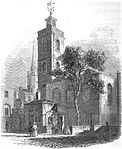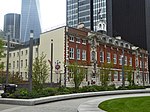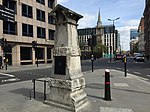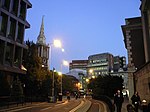Great Synagogue of London
1790 establishments in England18th-century synagoguesAshkenazi Jewish culture in EnglandAshkenazi synagoguesBritish synagogues bombed by the Luftwaffe ... and 4 more
Former synagogues in LondonReligion in the City of LondonReligious buildings and structures completed in 1790Synagogues destroyed by Nazi Germany

The Great Synagogue of London was, for centuries, the centre of Ashkenazi synagogue and Jewish life in London. Built north of Aldgate in the 17th century, it was destroyed during World War II, in the Blitz.
Excerpt from the Wikipedia article Great Synagogue of London (License: CC BY-SA 3.0, Authors, Images).Great Synagogue of London
Creechurch Place, City of London
Geographical coordinates (GPS) Address Nearby Places Show on map
Geographical coordinates (GPS)
| Latitude | Longitude |
|---|---|
| N 51.5141 ° | E -0.0779 ° |
Address
Creechurch Place 1
EC3A 5AF City of London
England, United Kingdom
Open on Google Maps










